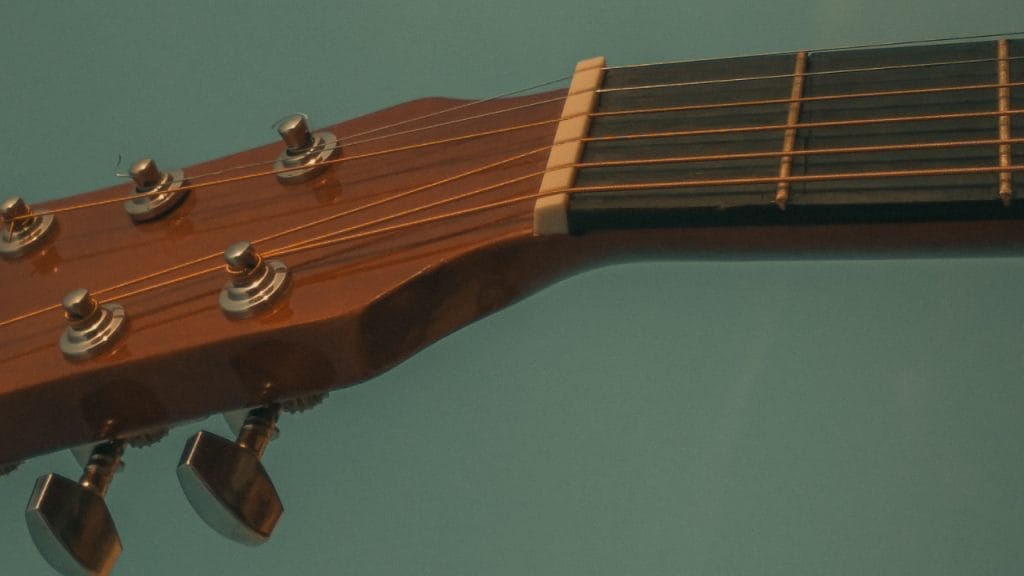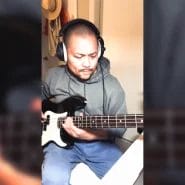Bass guitarists, like Jaco Pastorious and Victor Wooten, often use a technique known as chord melody for creating a solo bass arrangement of a song.
A bass guitar isn’t typically used as a solo instrument, but it’s becoming more common among modern bass players.
Knowing chord melody techniques can add a lot of depth to your playing and can be a nice effect for your solo bass arrangements.
Here’s what’s in this bass lesson:
- What you must know before writing any solo bass arrangement for a song.
- 3 important chord melody techniques that work great for the bass guitar.
- Bass lesson video breakdown of a solo bass arrangement, along with 15 chord melody techniques!
These approaches to melody and harmony I’ll show can be applied to a jazz standard to even a simple folk tune.
Let’s dive in!
TL;DR
If you’re short on time, watch my video that breaks down 15 chord melody techniques that I use on a bass solo arrangement of Joni Mitchell’s song “Both Sides, Now.”
What Is A Chord Melody?
The technique of playing chords along with a melody is called chord melody. While this technique involves the use of melody and chords interwoven into an arrangement, every melody note doesn’t need to have a chord underneath.
Pianists harmonize all the time using chord melody techniques. The piano lends itself to this sort of playing, because the fingers are free to play chord movements on a lower range, while other fingers are free to play the melody on a higher range. Jazz guitarists also play chord melodies often.
For bass players, it’s a different story. Only a single note per string can be sounded. Based on the number of strings you have on your bass, this can create some limitation to play the chords underneath the melody.
So, in order to create a solo arrangement or chord melody on the bass, you’ll have to be a little creative and use certain techniques.
Chord Melody / Solo Bass Arrangement Demonstration (Joni Mitchell’s “Both Sides, Now”)

It’s something special when both lyrics and music hit on a deep emotional level. Joni Mitchell “Both Sides, Now” is one of those songs.
I listened to this song when I was a kid and I’ve always loved the melody. I didn’t listen to the lyrics until much later.
Recently, I came across the tune again when my wife was playing music on Spotify. The app was playing a list of recommended songs and “Both Sides, Now” was playing.
I was immediately brought into a reflective state and I wanted to listen to the song over and over again. It also made me want to pick up my bass guitar and write a solo bass arrangement of this song.
In the video at the top of this post, I share what I came up with, along with a few tips for writing your own chord melodies on the bass guitar.
Before You Learn Chord Melody or Write A Solo Bass Arrangement For Any Song, Do This!
The single most important aspect of a solo bass arrangement is the melody. In other words, the listener should always be able to hear the melody.
The melody is the key ingredient to all chord melody arrangements. It keeps everything sounding together, determines the flow of harmony, and it’s the secret to finding basic chord changes.
Melody notes that fall on beat 1 or 3 of a measure, will typically be the root, third, or fifth of a chord. This information helps you figure our the chord changes that can go underneath the melody line.
The shape of a melody also serve as a guide for the voicings you’ll choose and the lines you’ll create.
So, before you start writing any arrangement of a song on the bass, you must learn the melody of the song.
You need to be comfortable playing the melody in different parts of your fretboard. It wouldn’t hurt to also be able to play the melody notes in different octave ranges on your instrument.
Don’t start until you’ve learned the notes of the melody.
The melody will make your entire process more easy!
Pro tip: Keeping your melody as the highest note for your chord melody approach is a good entry point if you’re starting out.
Chord Melody Arrangement Breakdown (15 Techniques For Getting Started)
In my YouTube video, I breakdown my thought process along with 15 easy chord melody techniques that I’m using for my arrangement of Joni Mitchell’s song “Both Sides, Now.”
These techniques can get you started with harmonizing melodies and writing your own solo arrangements on the bass.
Here’s a list of 15 techniques that are demonstrated in the video:
- Sustain a melody note
- Use Perfect 5ths (Power Chords)
- Contrary Motion for movement
- Thumb and Middle finger
- Sustain multiple melody notes
- Use open strings to expand the range
- Call-and-Response
- Flam your chords to widen the sound
- Use fills to create contrast
- Use dynamics to create contrast
- Change articulation to create contrast
- Throw in a soulful phrase
- Pedal tones
- Broken intervals
- Loud/soft or dense/sparse
- Add drama
3 Important & Easy Chord Melody Techniques For Bass Guitar
There are three things that are essential to making your own chord melody arrangements, and those three things can be found in the chord melody playing of great players like Victor Wooten, Jaco Pastorious, and Oteil Burbridge.
Technique #1: Play the melody on the upper voicing
The bass guitar can often sound muddy when too many notes are played in the lower range of the instrument.
So, in order to keep a good separation between the bass notes, chords, and the melody, the melody is often played on either the top two strings of the bass or the upper voicing.
If you’re on a 4-string bass (standard tuning), the top 2 strings will be the D string and the G string.
If you’re on a 6-string bass (standard tuning), the top 2 strings will be a G string and a C string.
In my chord melody demonstration above, I keep the melody of the tune in the upper voicing almost the entire time. Any bass note, line, or chord harmony is mostly placed with notes that are below the melody.
A note on voicing: I encourage you to explore drop-2 voicings. These particular chord voicings are easy to play on the bass guitar and lush sound to them.
Technique #2: Play Chords As A Call-and-Response
Using a fingerstyle approach, play chords and arpeggios in the spaces of the melody.
This approach is:
- easy on the fingers
- allows the melody to be easily heard
- creates a more orchestrated sound
- makes a simple melody sound great
- helps you find some interesting voicings, instead of playing the same chord shapes
- creates a call-and-response
Sometimes, I like to play a single line followed by a chord. Other times, I’ll play harmony and melody at the same time. Usually, I’ll play the melody on the top (melody note as the highest voicing). Every now and then, I’ll insert the melody into the inner voicings of the chord.
There’s no hard rule that you have to play a chord for every note of the melody. The best part about this approach, is that your other fingers are free to pluck out the chord tones of a basic chord. I’ll hear jazz guitar players, like Joe Pass do this often.
Let the melody be your guide and fill in the spaces.
Technique #3: Use Contrast With Your Voicings To Allow The Melody To Be Obvious
Contrast is a super important practice in music and it’s simple to do.
If the melody is in the upper range, support it with bass notes and chords in a lower range.
If the rhythm of the melody is syncopated, keep the rhythm of the low-end simple.
There are other aspects of music where you can apply contrast:
- the shape of the line
- direction of notes
- dynamics
- and many other things
Now It’s Your Turn
Playing a chord melody or solo bass arrangement is a lot of fun to do and it’ll teach your ears to hear lines that you normally wouldn’t play on the bass.
Since playing melody with chords is normally done by pianists and guitarists, I recommend that you listen to a lot of jazz players, particularly solo guitar chord melodies. Chord melody on guitar is easy to translate on the bass guitar. And, you’ll start hearing ways to harmonize a melody and build your knowledge of chords quickly.
Listen to how the fingerstyle techniques are used to create a sound and adopt that into your playing.
The best way to learn this stuff is to just start doing it.
If you want to expand your technique, touch, and creative expression, explore more concepts inside Technique & Groove →
Frequently Asked Questions
What is chord melody on bass guitar?
Chord melody on bass is when you play the melody and harmony at the same time on a single bass guitar. Instead of only playing root notes or grooves, you combine chords, double-stops, and bass notes with the song’s main melody so the arrangement sounds complete even without a band.
Do I need advanced theory to start chord melody on bass?
No. You don’t need to know every mode or reharm concept to start. What you do need is:
– A solid grip on the melody notes (know the melody very well)
– Basic chord types (major, minor, dominant, maybe a few 7th chords)
– Comfort playing simple voicings on the upper strings
From there, you can use techniques like power chords, pedal tones, and call-and-response chords to build convincing solo bass arrangements.
Why is it better to play the melody on the upper strings?
Playing the melody on the upper strings (D and G strings on a 4-string; G and C on a 6-string) keeps it clear and singable. The low register of the bass can get muddy when you stack too many notes. By placing the melody high and chords or bass notes below, you create clarity and contrast, which makes the song recognizable.
How do I start arranging a song for solo bass chord melody?
Start with these steps:
1) Learn the melody by ear or from a chart and play it confidently in at least one position.
2) Identify where melody notes fall on beats 1 and 3—they’re often the root, 3rd, or 5th of the underlying chord.
3) Try adding simple chord shapes or power chords under or around those melody notes.
4) Use call-and-response: melody bar, then a bar of chords, fills, or pedal tones.
You don’t have to harmonize every note—just enough to imply the changes.
What voicings work best for chord melody on bass?
On bass, the most practical voicings are:
Power chords (root + 5th)
– Simple 3-note voicings on the top strings
– Drop-2 voicings (my personal favorite), which often sit beautifully across adjacent strings
Because we’re limited to one note per string, these compact voicings keep things playable while still sounding lush.
How can I keep the melody clear when I’m adding chords and fills?
Use contrast as your guiding principle:
– Keep the melody in a higher register than your chords and bass notes.
– If the melody rhythm is syncopated or busy, keep the chords simple and grounded.
– Use dynamic contrast—softer accompaniment, stronger melody notes.
– Don’t be afraid to sustain a single melody note while moving harmony underneath it; this creates space and keeps the listener focused on the tune.









